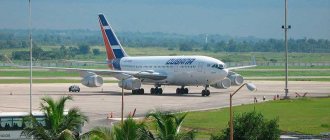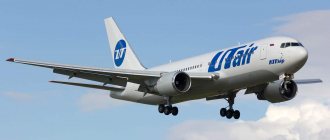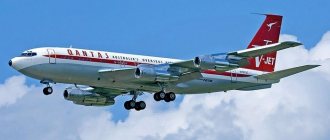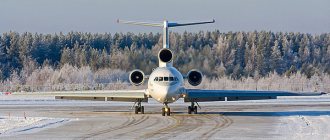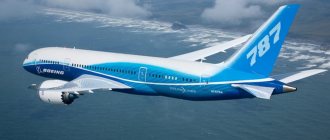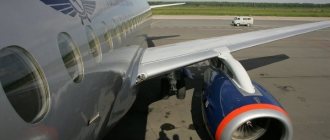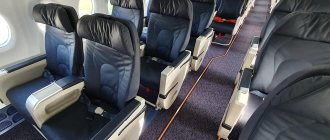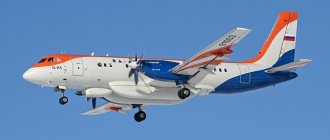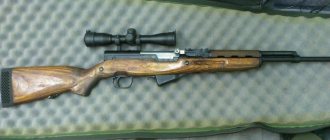The AN-74 aircraft was designed on the basis of the AN-72 transport aircraft for transportation in the Arctic. The developer of the aircraft is the Kiev ASTC named after. Antonov. The model was put into operation on July 3, 1991, and has since been used by airlines in more than twenty countries around the world. There are civil and military modifications, which, in turn, are divided into cargo, cargo-passenger, passenger, special, military transport and patrol.
Brief description and purpose of the aircraft
The AN-74 aircraft is a cantilever all-metal monoplane with a high-mounted low-sweep wing and a T-shaped single-fin tail. The aircraft's power plant includes two turbo-ventilated by-pass engines D-36 series 1-A, which are cantilevered to the center section in such a way that their jet streams blow over the upper surface of the wing, creating additional lift.
The aircraft is designed for use in the most extreme climatic conditions in operating temperature ranges from -60 to +45 degrees Celsius, at high altitudes, but its main purpose is to operate in the Arctic, Antarctica and adjacent regions.
The AN-74 is intended for conducting visual ice reconnaissance, piloting ships, transporting cargo and passengers, searching for schools of fish, performing special work when organizing drifting research stations and supporting research work in the central Arctic basin.
Purpose
The Yak-12 aircraft was widely used in agriculture.
This machine was used to fertilize plants, sow, and pollinate fields and plantings. It could also serve as an ambulance. The Yak-12 aircraft was used as a postal carrier and tug. As a passenger transporter, this aircraft was ideal on minor routes. The car was designed for two passengers and could withstand a load not exceeding 350 kilograms. The Yak-12 aircraft was also used in flight schools for parachute jumping. The structure and design of this multi-purpose aircraft were characterized by simplicity and unpretentiousness in use, the presence of radio stations and instruments that made it possible to fly both at night and under adverse weather conditions. Besides the Soviet Union, the aircraft was used in China and Poland, where it was produced as the PZL-101 Gawron.
Certification
The aircraft meets the requirements of aircraft airworthiness standards and additional airworthiness requirements for the AN-74 aircraft, which take into account its design and operational features, which together with the specified standards form the “Certification basis for airworthiness”. Approved by the Executive Committee of the SNLG of the USSR on May 17, 1991 and introduced by the Presidium of the Council of the SNLG of the USSR on July 3, 1991.
History of creation
The military initially wanted to get a vehicle for transporting sabotage groups, preferably with vertical take-off. The designers, having studied the technical specifications, came to the conclusion that a transport VTOL aircraft would be too expensive and complex, but an aircraft with a short take-off would be more profitable from an economic point of view.
During the design process, the design bureau decided not to limit the aircraft’s capabilities to transporting saboteurs. As a result, in order to maintain the required takeoff and landing characteristics, we had to resort to a number of original solutions, which will be discussed later.
In 1975, the development of the An-72 was completed.
Prototypes were built in Kyiv, at the mechanical plant at the Antonov Design Bureau and at the aviation production association. The first 2 prototypes served for ground testing, and in the air they were supposed to test a series of 4 aircraft. At the end of the summer of 1977, the An-72 made its first flight, and in the winter, TASS announced the new aircraft to the Soviet people.
In 1979, the An-72 was modified and demonstrated at the international air show in France. At the end of the same year he was presented for state tests. The base aircraft and its civilian modification, the An-74, were recommended for production.
Production of the An-72 and An-74 began in 1981 in Kharkov, but the first samples were assembled only in 1985.
AN-74: engine characteristics
The main engine D-36 series 1A is installed. Turbojet unit D-36 ser. 1A is made with an axial compressor according to a three-shaft design, an annular combustion chamber, an intermediate casing, a five-stage turbine and separate unregulated output nozzles of the internal and external circuits. Installation weight (dry) – 1.1 tons.
Motor data by mode:
| Fuel consumption, kg/kg.hour | Thrust, Kg | |
| takeoff mode | 0,375 | 6500 |
| nominal mode | 5000 | |
| maximum cruise mode | 0,65 | 1600 |
| terrestrial idle gas mode | 400 |
The time of continuous operation of the D-36 in takeoff mode is no more than 5 minutes, in ground idle mode - no more than 30 minutes, in nominal and cruising modes - without limitation within the service life of a particular aircraft.
Tests
In 1950, the Yak-12 UT was tested at the NIIVVS Group of Companies and was recommended for air force flight schools as an effective simulator for training flight personnel. The following disadvantages were identified:
- 1700 blade revolutions per minute indicated the weak power of the GSK-1500 wind generator.
- The antenna used had insufficient power - the receiver only worked at an altitude of no higher than 1850 meters.
- The range of the compass was 160 km. This was not enough, since the commission put forward requirements of at least 180 meters.
After testing in June, a repeat test was scheduled in October of the same year. After modifications, the Yak-12 UT was equipped with:
- the VD-5 wind engine, which was characterized by a change in the pitch of the blades during flight;
- The installed T-shaped antenna worked effectively at any height.
In 1952, this aircraft successfully passed new tests. But nevertheless, nowhere in the documents is it listed as the Yak-12 UT.
Auxiliary gas turbine engine
The TA-12 auxiliary power unit (APU) engine is a single-shaft gas turbine with the extraction of compressed air and alternating current electrical energy with an available power of 40 kVA. The unit is installed in the unsealed compartment of the right fairing of the aircraft landing gear and is intended for:
- air launch of D-36 main engines on the ground at altitudes up to 3600 m and in flight at altitudes up to 6000 m;
- supplying compressed air to the aircraft air conditioning system on the ground at altitudes up to 3600 m;
- powering the aircraft's on-board network with alternating current electricity on the ground at altitudes up to 3600 m and in flight in the event of failure of the main power sources up to 9000 m.
The TA-12 engine consists of a gearbox, a four-stage axial compressor, a counterflow annular combustion chamber, and a three-stage axial turbine.
Aeroblasting AN-200, AN-200M, AN-200D, AN-200MD pressure-type abrasive blasting units
Designed for cleaning surfaces from layers of rust and paint, as well as for preparing surfaces before applying anti-corrosion coatings.
Execution:
AN-200
- standard: pressure-type installation, sieve, lid, dosing valve for working with any abrasive material with a fraction of 0.2 - 4 mm, DN 25/32);
AN-200M
— additionally equipped with an oil and water separator;
AN-200D
— additionally equipped with remote control KPU REMCON X;
AN-200MD
— additionally equipped with an oil-water separator and remote control of the REMCON X KPD.
Characteristics:
- Hopper volume - 200 l;
- Working pressure - 5-8.3 kgf/cm2;
- Productivity - 5-30 m2/hour;
- Air flow - 3-10 m3/min;
- Climatic modification - UHL 3;
- Work with any type of abrasive material from 0.025 to 4 mm;
- Dimensions - 960 x 870 x 1500 mm;
- Weight 156 kg.
Advantages:
The devices are installed on powerful supports: the supports are located at a distance of 5 mm from the floor level.
The entire load of the loaded apparatus falls on the supports, which can withstand a load of at least 1000 kg.
This allows you to increase the service life of the wheels and increases the stability of the device during operation.
Ergonomic and mobile design A comfortable handle combined with wheel supports makes it easy to move the device.
Correct balancing allows you to hold the device on weight with minimal effort, at an angle of up to 45°.
When the device overturns, the handle protects the pneumatic line from damage and deformation.
The location of the attachments allows for quick and convenient maintenance, repair and replacement of components and units of the device.
Oil and moisture separator filter CAF-3 is of cyclone type with a filter element made of pressed brass balls ACS-32.
Prevents moisture and oil condensation from entering the pressure tank of the sandblaster. Used to separate moisture and oil from the compressed air stream supplied to an abrasive blasting unit or compressed air powered tool. Required when working with piston compressors and compressors that have natural wear, as well as at low ambient temperatures. Condensate is drained manually.
Can be used with abrasive blasting machines of any model and manufacturer.
- Productivity: 400m3/hour;
- The efficiency of purifying compressed air from moisture and oil is up to 98%;
- Connection diameter - 1 ½” inches (DN32);
- Maximum pressure 13 Atm.
- Dimensions: 165 x 400mm;
- Weight 2.4 kg;
- Degree of purification 0.3 microns.
The REMCON X Pneumatic Remote Control Kit for Pressure Blasters allows the operator to remotely turn on and off the compressed air supply to the blast machine.
When the control key is pressed, the air flow opens the inlet chamber, through which compressed air is supplied to the pressure tank, and the valve, when moving upward, clamps the pressure release membrane, which allows the compressed air to create pressure in the abrasive blasting unit in a few seconds.
Triggering in less than 1 second when applying or releasing pressure complies with all international standards and regulations adopted for this type of product.
KPDU REMCON®X ensures safe operation in accordance with GOST 31335-2006 and allows you to significantly save compressed air, abrasive material, electrical energy or diesel fuel, and reduce labor costs.
The RAV I control key (included in the REMCON X control unit) is designed to control the abrasive blasting machine at a distance of up to 60 meters.
It is installed on the abrasive blasting hose at a distance of 200 mm from the nozzle holder and is used to control the “on-off” function.
The convenient and safe design of the key allows you to easily control the processing process of products.
The key is equipped with a special safety flag that prevents accidental activation of the device and immediately turns it off if the operator loses control.
The universal dispenser for adjusting the amount of supply of abrasive material SGV is used to work with any abrasive materials. It has proven itself to be excellent when working with “heavy” abrasive materials (steel and cast iron, round and crushed shot and other metal materials).
Only one element is subject to wear and periodic replacement, which has a positive effect on the durability and reliability of the product.
The abrasive supply is adjusted using the handle. Rotating the handle clockwise until it stops completely closes the dispenser. Rotating the handle counterclockwise until it stops will open the dispenser completely. The handle rotates ¼ of a full turn at a time, the waiting interval for the result to stabilize the abrasive flow is 10-15 seconds. If necessary, the action is repeated.
The best result is achieved with an optimal ratio of the amount of abrasive and compressed air, which is determined visually by the mixture of the jet and the absence of pulsations.
A quickly replaceable insert made of wear-resistant rubber for the SGV dispenser is used to regulate the flow of abrasive material by pinching it with the valve rod and protecting the valve body from wear.
The diameter of the insert through hole is 27 mm. The insert requires periodic replacement, especially for large volumes of work.
The AN-200 installation is supplied with the following kits:
AN-200:
- Pressure type apparatus, sieve, lid, pneumatic line, SGV dispenser;
- Nozzle holder;
- Set of connections for connecting air and abrasive hoses;
- Passport of a pressure vessel;
- Operating manuals.
AN-200M:
- Pressure type apparatus, sieve, lid, pneumatic line, SGV dispenser;
- Oil and moisture separator;
- Nozzle holder;
- Set of connections for connecting air and abrasive hoses;
- Passport of a pressure vessel;
- Operating manuals.
AN-200D:
- Pressure type apparatus, sieve, lid, pneumatic line, SGV dispenser;
- Remote control unit;
- Nozzle holder;
- Set of connections for connecting air and abrasive hoses;
- Passport of a pressure vessel;
- Operating manuals.
AN-200MD:
- Pressure type apparatus, sieve, lid, pneumatic line, SGV dispenser;
- Oil and moisture separator and remote control unit;
- Nozzle holder;
- Set of connections for connecting air and abrasive hoses;
- Passport of a pressure vessel;
- Operating manuals.
Fuel used
The following fuels are used to refuel the AN-74: PT, TC-1 and T-1 without anti-crystallization liquids. It is allowed to mix the specified brands of fuel in any proportions and use them with Sigbol additives, liquids “I”, “I-M”, “THF”, “THF-M” and their analogues. It is allowed to use fuel of foreign brands and with additives that meet accepted standards.
Exploitation
Despite the fact that the An-72 was created on instructions from the military, it never really took root in the Air Force. Only one special purpose division and one separate air regiment were equipped with Cheburashkas. The remaining vehicles that fell into service with the troops were used only sporadically for the transfer of personnel and vehicles. Border guards used aircraft more actively - in the Far East, An-72s even entered into battle with border violators and poachers.
Civilian vehicles fared little better. Most airlines preferred the more economical An-26 with turboprop engines. But the An-74 is actively used by polar explorers, for whom this machine was created. In addition, the An-72, and then the An-74-200, found an “ecological niche” in the aviation of African countries, where their fairly high payload capacity and ability to take off from unprepared sites are highly valued.
Resource
- The aircraft's full service life (before decommissioning) is 40,000 flight hours, or 20,000 landings, or 20 years of operation.
- The initial assigned life of the airframe, landing gear and mechanical elements of the control and configuration system is 10,000 flight hours, 5,000 flights.
- The initial designated resource of the D-36 series 1A engine is 1000 flight hours.
- The initial assigned resource of the VGTD TA-12 is also 1000 flight hours or 2500 launches.
Aircraft design
Initially, the aircraft was designed for the air force as a two-seater aircraft capable of performing medical and communications missions. The Yak-12 was a mixed design: welded chromansil pipes were used to produce the fuselage base. The frames of the two-spar wings, tail units and ailerons were made of duralumin. The wings and tail section themselves were covered with canvas. Duralumin was used to cover the bow. Wood became the basis for the production of aircraft formwork slats. The air ambulance was equipped with a fixed duralumin wing liner. To reduce resistance, a special tape was installed in the pyramid-type chassis - a guy wire.
The cabin of the aircraft was of the automobile type and could accommodate up to four people. If necessary, a stretcher was installed on its right side for transporting the wounded. The very first Yak-12 aircraft were equipped with an M-11FR engine of 160 hp. With. and with cooling. Over time, wood was replaced with duralumin in the aircraft design.
Emergency equipment
To ensure emergency escape of the crew and passengers in the event of a forced landing of the aircraft on land or water, the aircraft is equipped with emergency exits, and there are also places for opening additional exits outside the fuselage.
The aircraft is equipped with the following emergency rescue equipment (ARO): ropes, an ax, first aid kits, light signs with the words “Exit”, an emergency lighting system, signaling and communication equipment, radio stations - one P-861 and two P-855UM.
For flights over deserts, arctic or tropical areas, equipment locations with life support equipment appropriate to the conditions of the area are provided. In case of a forced landing on water, the AN-74 will maintain a buoyant and stable position for the time required for the emergency evacuation of passengers and crew members.
When flying over water, the following ASO is additionally installed:
a) for a flight duration of less than 30 minutes from the shore - life jackets according to the number of passengers and crew members carried and one demonstration vest;
b) for a flight duration of more than 30 minutes from the shore - inflatable life rafts.
Assembly
When assembling the product, it is important to ensure that the laminated side is on the outside. An important aspect is compliance with the dimensions of the cut parts with the dimensions of the battery - it may be larger than planned in the drawing. It is recommended to take measurements first using a ruler. For strong bonding, it is advisable to use clothespins, weights or a vice. To form the required bend, rolling on the pipe can be used. After this, all parts of the Yak-12 in contact with each other are glued together.
A radio-controlled airplane model, the flight of which is often associated with falls, needs to strengthen the structure. Reinforcement with tape will help to give strength to the manufactured product. It is recommended to use stiff wire to attach servos. The motor frame on which the motor is mounted must be made of thin plywood. It is very convenient to screw the mounting screws onto it. If you don't have a piece of plywood, you can also use plastic, aluminum or foam. The main thing is that the material is light. It is desirable that the weight of the manufactured model does not exceed 600 grams. It is recommended to launch the product with one throw from the hand. To begin with, landing should be done with the belly of the aircraft on a soft surface. To do this, it is not necessary to mount wheels on the structure.
The cost of a Ford Focus or Pegout 3008 is equal to the price of such an aviation creation as the Yak-12 aircraft. The photo below shows the features of its external design. But it should be recalled that different modifications were produced.
Nowadays, the Yak-12 aircraft is considered a rarity. It can be found among aircraft collectors.

